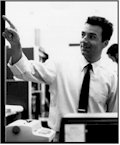by
James Redin
"When my washing machine breaks, I call the Sears repairman. When a clever person's machine breaks, he goes down to Sears, buy a new part and installs it himself. But if Ted's machine breaks, he analyzes the problem, redesigns the faulty part, casts it in his own crucible, polishes it on his lathe, and installs it himself - and the machine works better than ever." Ted Hoff's colleague. "Bit by Bit - An Illustrated History of Computers" by Stan Augarten. |
 Yes, Dr. Marcian "Ted" Hoff
was not just a good engineer. Born in 1937, he got his Ph.D. in Electrical Engineering
from Stanford University in 1962. His skills combined with his "there has got to be a
better way" philosophy led him to the invention of the
microprocessor two years after joining INTEL in 1968. Yes, Dr. Marcian "Ted" Hoff
was not just a good engineer. Born in 1937, he got his Ph.D. in Electrical Engineering
from Stanford University in 1962. His skills combined with his "there has got to be a
better way" philosophy led him to the invention of the
microprocessor two years after joining INTEL in 1968.INTEL was a young company founded in 1968 by Dr. Robert Norton Noyce and Gordon E. Moore with the long-term purpose of developing the potential of the LSI (Large Scale Integration) technology. Dr. Noyce, while working for Fairchild Semiconductor Corp., and Jack Kilby while working for Texas Instruments, co-invented the Integrated Circuit (IC) in 1959. INTEL's initial project was to use this technology to replace the transistor-based computer memories which were too bulky and expensive to compete with the core-ferrite memory used in computers and early calculators. On those days, the market of the calculators was dominated by the manufacturers of electro-mechanical calculators such as Monroe, Friden, Marchant and Victor. Electronic calculators, such as the WANG 380 were expensive. The invention of the IC's encouraged entrepreneurs to find potential applications for this recent discovery. Busicom, a Japanese company, was one of the companies that saw in the IC's a way to develop small and affordable electronic calculators for the general public. It was September of 1969 when Busicom approached INTEL looking for a company able to manufacture the set of IC's that they have designed to build a series of electronic calculators. An agreement was signed in February 6, 1970, and INTEL assigned the project to Ted Hoff. Busicom's specs contained the full description of a set of twelve chips that would serve their purpose, some of them required to pack more than 5000 transistors in a single chip, which was a challenge for INTEL who was packing 2000 bits in their memory chips. The project, although complex, was a feasible one. But, of course, Ted Hoff had to find a better way. After reviewing the specifications, Ted Hoff decided that it was not good business for INTEL to set a manufacturing process for every specific customer that INTEL may have in the future. This would not only be impractical for INTEL but also expensive for the customer. Familiar with the PDP-8 minicomputer from Digital, Ted Hoff found that a better approach would be to pack enough of the logic of a minicomputer in a single chip so to perform minor tasks as the ones required by a calculator and other similar devices. The program that would control the specific behavior of this packed microcomputer chip would be stored in a special ROM (Read Only Memory) chip that INTEL or the customer would program to handle the specific application. A third chip would handle the temporary storage of data required by the CPU, and finally, a fourth chip would handle the I/O (Input/Output) operations to interface with the external devices such as the keyboard and the display. As an example if its potential, for an electronic calculator this approach required only four chips instead of the twelve chips proposed by Busicom. Even more, the number of transistors packed in the most complex chip was reduced from 6000 to less than 2500, and the same four chips could be used for many other devices. Dr. Hoff's solution was just brilliant. INTEL and Busicom agreed to go ahead with the project but Busicom would retain the exclusive rights on the set of chips. After one year of development by Ted Hoff, Stanley Mazor and Federico Faggin of INTEL, and with the cooperation of Masatoshi Shima, the author of Busicom specifications, the INTEL 4004 4-bit microprocessor was born in 1970.
Later, in April 1972, INTEL launched the INTEL 8008 8-bit microprocessor, followed by the INTEL 8080 with 15,000 transistors in 1974, followed by the INTEL 8086 16-bit microprocessor in 1978, followed by the INTEL 8088 in 1979, followed by the INTEL 80286 with 100,000 transistors in 1984, followed by the INTEL 80386 32-bit microprocessor in 1989, followed by the INTEL 80486 with 1,180,235 transistors in 1990, followed in 1993 by the PENTIUM with 3.1 million transistors, and in 1995 by the PENTIUM PRO with 5.5 million transistors packed in a single chip! The number of components in a single chip has been doubling every eighteen months . This exponential rate was predicted by Gordon Moore, INTEL's co-founder, and is known as the Moore's Law. Chips appear to follow obediently this law. |
| Reference Sources: Stan Augarten, "Bit by Bit - An Illustrated History of Computers," Ticknor & Fields, New York, 1984. G. Harry Stine, "The Untold Story of the Computer Revolution - Bits, Bytes, Bauds, and Brains," Arbor House, New York. INTEL, "A Trio of Intel Inventors Make History." INTEL, "25th Anniversary of the Microprocessor." William Aspray, "Masatoshi Shima Interview," IEEE Center for the History of Electrical Engineering, May 17, 1994. Haim Mendelson and Anne Korin - The Computer Industry: A Brief History - The Chip Mark W. Greenia, "Computers and Computing: A Chronology of the Men and Machines that Made Computer History," Lexikon Services Publications, 1990. Bobbi A. Kerlin "INFORMATION and COMMUNICATION TECHNOLOGY. Timeline of Significant Events." |